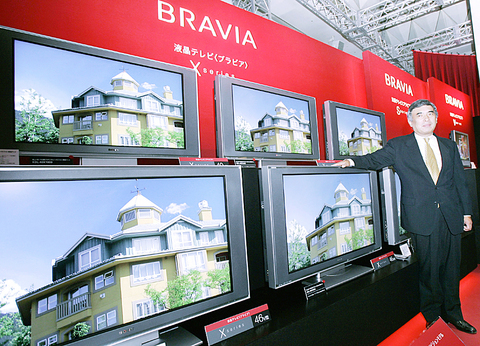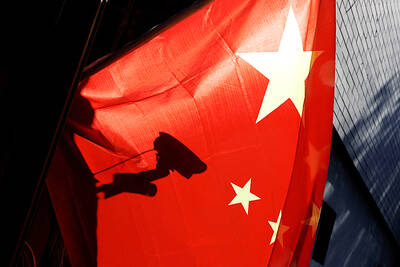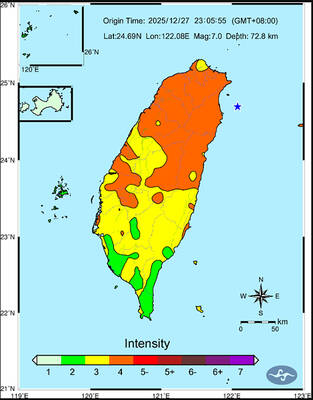Samsung Electronics Co and Sony Corp had to overcome cultural barriers in their joint liquid-crystal display (LCD) venture but by doing so created a new market, according to a top Samsung executive.
The two global electronics giants established S-LCD Corp in the city of Asan, about 90km south of Seoul, in April 2004 to produce panels to meet soaring demand for flat screen televisions.
Sony's Japanese devotion to detail ran up against Samsung's Korean-style emphasis on speed, Lee Sang-wan, president and CEO of Samsung's LCD business, told reporters.

PHOTO: AP
"So at first it worked as a cultural barrier between the two companies or two countries but now it is becoming a synergy," he said. "They are very detail oriented and we are very speedy at working."
Lee made the comments on Friday but they were embargoed for release till yesterday by Samsung.
Global demand for flat screen televisions has soared as consumers abandon their bulky cathode ray tube sets for the thinner, sleeker versions.
Samsung said on Thursday it expects the global market for LCD TV panels to grow 53 percent to 73 million units next year.
Samsung and Sony currently produce 40-inch and 46-inch panels using Samsung technology at their "seventh-generation" production line, a sleek, state-of-the art facility staffed by industrial robots and humans working in special "clean rooms."
"We created the 40-inch LCD TV market with Sony," said Lee, who attributed its success to the popularity of Samsung's Bordeaux and Sony's Bravia models, which both use panels made at the facility in Asan's Tangjeong district.
"Sony's role in opening that market and realizing growth has been important," he said.
The companies, whose products such as televisions and personal computers compete against each other in global markets, cooperate in LCD panels to ensure supply.

A magnitude 7.0 earthquake struck off Yilan at 11:05pm yesterday, the Central Weather Administration (CWA) said. The epicenter was located at sea, about 32.3km east of Yilan County Hall, at a depth of 72.8km, CWA data showed There were no immediate reports of damage. The intensity of the quake, which gauges the actual effect of a seismic event, measured 4 in Yilan County area on Taiwan’s seven-tier intensity scale, the data showed. It measured 4 in other parts of eastern, northern and central Taiwan as well as Tainan, and 3 in Kaohsiung and Pingtung County, and 2 in Lienchiang and Penghu counties and 1

FOREIGN INTERFERENCE: Beijing would likely intensify public opinion warfare in next year’s local elections to prevent Lai from getting re-elected, the ‘Yomiuri Shimbun’ said Internal documents from a Chinese artificial intelligence (AI) company indicated that China has been using the technology to intervene in foreign elections, including propaganda targeting Taiwan’s local elections next year and presidential elections in 2028, a Japanese newspaper reported yesterday. The Institute of National Security of Vanderbilt University obtained nearly 400 pages of documents from GoLaxy, a company with ties to the Chinese government, and found evidence that it had apparently deployed sophisticated, AI-driven propaganda campaigns in Hong Kong and Taiwan to shape public opinion, the Yomiuri Shimbun reported. GoLaxy provides insights, situation analysis and public opinion-shaping technology by conducting network surveillance

‘POLITICAL GAME’: DPP lawmakers said the motion would not meet the legislative threshold needed, and accused the KMT and the TPP of trivializing the Constitution The Legislative Yuan yesterday approved a motion to initiate impeachment proceedings against President William Lai (賴清德), saying he had undermined Taiwan’s constitutional order and democracy. The motion was approved 61-50 by lawmakers from the main opposition Chinese Nationalist Party (KMT) and the smaller Taiwan People’s Party (TPP), who together hold a legislative majority. Under the motion, a roll call vote for impeachment would be held on May 19 next year, after various hearings are held and Lai is given the chance to defend himself. The move came after Lai on Monday last week did not promulgate an amendment passed by the legislature that

AFTERMATH: The Taipei City Government said it received 39 minor incident reports including gas leaks, water leaks and outages, and a damaged traffic signal A magnitude 7.0 earthquake struck off Taiwan’s northeastern coast late on Saturday, producing only two major aftershocks as of yesterday noon, the Central Weather Administration (CWA) said. The limited aftershocks contrast with last year’s major earthquake in Hualien County, as Saturday’s earthquake occurred at a greater depth in a subduction zone. Saturday’s earthquake struck at 11:05pm, with its hypocenter about 32.3km east of Yilan County Hall, at a depth of 72.8km. Shaking was felt in 17 administrative regions north of Tainan and in eastern Taiwan, reaching intensity level 4 on Taiwan’s seven-tier seismic scale, the CWA said. In Hualien, the